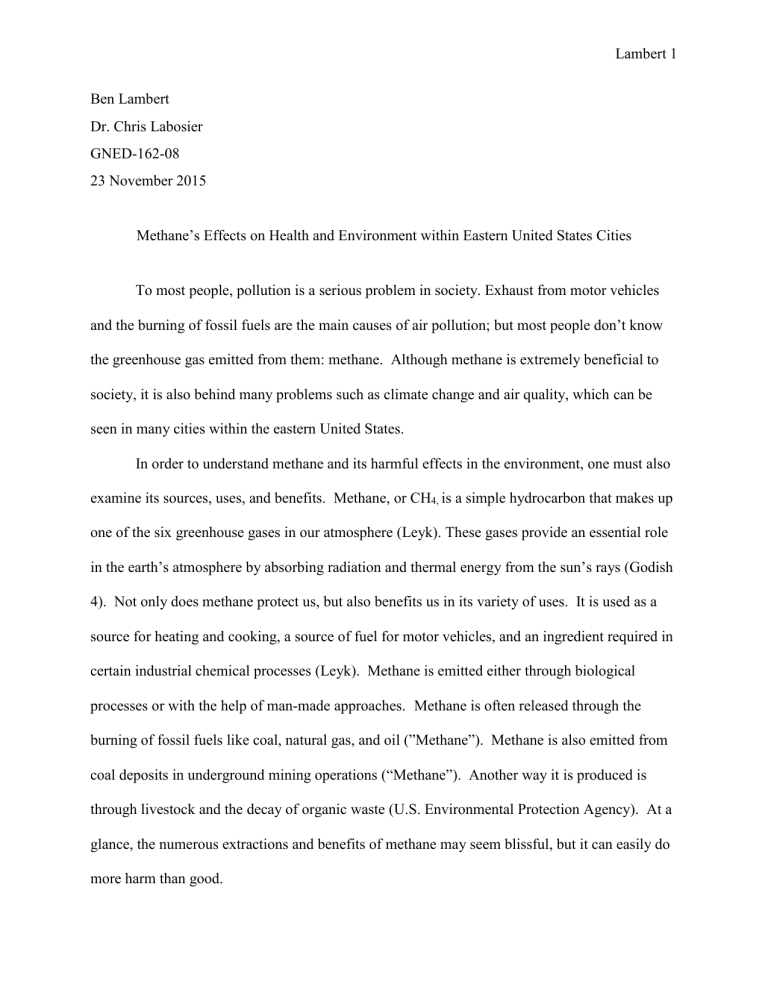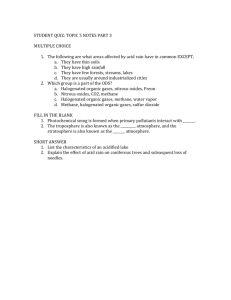polluted emissions

Lambert 1
Ben Lambert
Dr. Chris Labosier
GNED-162-08
23 November 2015
Methane’s Effects on Health and Environment within Eastern United States Cities
To most people, pollution is a serious problem in society. Exhaust from motor vehicles and the burning of fossil fuels are the main causes of air pollution; but most people don’t know the greenhouse gas emitted from them: methane. Although methane is extremely beneficial to society, it is also behind many problems such as climate change and air quality, which can be seen in many cities within the eastern United States.
In order to understand methane and its harmful effects in the environment, one must also examine its sources, uses, and benefits. Methane, or CH
4, is a simple hydrocarbon that makes up one of the six greenhouse gases in our atmosphere (Leyk). These gases provide an essential role in the earth’s atmosphere by absorbing radiation and thermal energy from the sun’s rays (Godish
4). Not only does methane protect us, but also benefits us in its variety of uses. It is used as a source for heating and cooking, a source of fuel for motor vehicles, and an ingredient required in certain industrial chemical processes (Leyk). Methane is emitted either through biological processes or with the help of man-made approaches. Methane is often released through the burning of fossil fuels like coal, natural gas, and oil (”Methane”). Methane is also emitted from coal deposits in underground mining operations (“Methane”). Another way it is produced is through livestock and the decay of organic waste (U.S. Environmental Protection Agency). At a glance, the numerous extractions and benefits of methane may seem blissful, but it can easily do more harm than good.
Lambert 2
Although methane and other greenhouse gases are essential to protecting the earth and life within it, there is such a thing as “too much”. Too many greenhouse gases can lead to climate change and global warning (Leyk). The greenhouse gases eventually reach the point of entrapping too much heat, warming the entire planet in the process. Methane plays a huge role in this process, even more so then carbon dioxide. Although there is more amounts of carbon dioxide in the atmosphere than methane, methane is “25 times as effective as CO2 at trapping heat in the atmosphere, and over the last two hundred and fifty years, the concentration of CH4 in the atmosphere increased by 152 percent (“U.S. Environmental Protection Agency”).
Methane also produces several health concerns. When one is outside, they are already exposed to low levels of methane; after all, it is everywhere in the atmosphere. But continual and prolonged exposure to methane can cause oxygen deprivation, which can lead to a dizzy feeling or lack of consciousness (“Methane”). Other effects include “increased heart rate, low blood pressure, and numbness in the limbs (“Methane”). This not only poses risks for people that work around fossil fuels, but also to people who live in overpopulated and industrialized cities.
Many cities located in the eastern part of the United States have experienced negative effects from methane, greenhouse gases, and other man-made emissions. These are large cities that are characterized by high amounts of traffic congestion, long-distance commutes from the suburbs, and large urbanization and mass production. On a pollution index of the Americas (the lowest amount being 5.17 and the highest 87.87), many cities in the eastern United States were listed. Atlanta was ranked the highest (68.87), followed by New York (58.36), Philadelphia
(48.96), Pittsburgh (44.28), Boston (29.49), Washington D.C (28.99), and finally Richmond
(24.93) (“Pollution”). New York City has attributed 6% of its death to air pollution (“Air
Pollutants in New York City”). Pittsburg is another city that has severe pollution problems. Due
Lambert 3 to its abundance of factories, traffic congestion, and power plants, the city has become an environmentally hazardous place to live in. In fact, Pittsburgh citizens have twice the risk to develop cancer than in any other area in Pennsylvania (Atkin). The air has been so heavily polluted throughout the decades that diseases such as cancer can be caught just from exposure to outside air. The problem has gotten so bad that Pittsburgh and the surrounding Allegheny
County received an F with regard to air quality (Hopey). Atlanta had the highest pollution index among those who were listed. This is due to long commutes to the city. The city’s average daily commute is thirty-five miles, which doesn’t even make room for back-ups and congestion
(Copeland). The estimated three million inhabitants together drive on average about 115.6 miles per day, which equals a trip to the sun and halfway back (Copeland). Methane is obviously a factor at play, as it “accounts for 15% of motor vehicle emission and 70% of urban concentrations after correcting for background levels” (Godish 50). If this continual emission continues throughout these cities, they might soon experience dangerous health effects like those seen in Pittsburgh.
In conclusion, methane poses serious threats to everyday living. If not controlled, methane emissions will continue to increase at a steady rate. If it is bad enough now, one must think how bad the air quality will be in future generations. There are, however some easy ways to limit methane emission. One of the easiest solutions is to reduce motor vehicle emission.
Carpooling or using public transportation is a great way to individually affect emission. Another way is to conserve heat or electricity as much as possible. Society as a whole could also do better by using renewable or alternative sources of energy. The government also sees the growing concern. The Obama administration announced that the EPA would upgrade standards to reduce methane emissions in landfills, and that Energy and Agriculture Departments will use
Lambert 4 methane digesters to reduce emissions from cattle (Davenport). It is true; it might be too late to stop global warming and climate, but people can still work together to slow down the air pollution and allow future generations to live in a healthier environment.
Lambert 5
Works Cited
"Air Pollutants in NYC." Air Pollutants in NYC . N.p., n.d. Web. 23 Nov. 2015.
Atkin, Emily. "Pittsburgh’s Unique Air Pollution Makes Its Residents More Susceptible To
Cancer, Study Says." Think Progress . N.p., 22 Nov. 2013. Web. 23 Nov. 2015.
Copeland, Larry. "Atlanta Pollution Going Nowhere." USA Today . USA Today, 31 Jan. 2001.
Web. 23 Nov. 2015.
Davenport, Coral. "White House Unveils Plans to Cut Methane Emissions." The New York
Times . The New York Times, 28 Mar. 2014. Web. 23 Nov. 2015.
Godish, Thad. Air Quality . Boca Raton, FL: CRC/Lewis, 1997. Print.
Hopey, Don. "Pittsburgh Region Still Gets Poor Marks for Air Pollution." Pittsburgh Post-
Gazette . Pittsburgh Post-Gazette, 29 Apr. 2014. Web. 23 Nov. 2015.
Leyk, Manja. "Methane." Salem Press Encyclopedia of Science . Research Starters, 2015. Web.
23 Nov. 2015.
"Methane." Tox Town . U.S. National Library of Medicine, 15 Oct. 2015. Web. 23 Nov. 2015.
"Pollution." Pollution . N.p., 2015. Web. 23 Nov. 2015. <http://www.numbeo.com/pollution/>.
U.S Environmental Protection Agency. "Overview of Greenhouse Gases." Greenhouse Gas
Emissions: Greenhouse Gases Overview . U.S Environmental Protection Agency, n.d.
Web. 23 Nov. 2015.
Lambert 6
U.S Environmental Protection Agency. "U.S. Greenhouse Gas Inventory Report: 1990-2013."
U.S. Greenhouse Gas Inventory Report: 1990-2013 . U.S Environmental Protection
Agency, 15 Apr. 2015. Web. 23 Nov. 2015.







